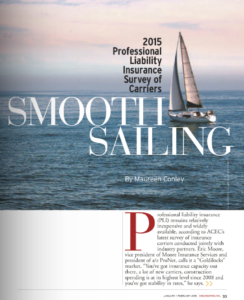
On April 27, 2017, Governor Jerry Brown signed Senate Bill 496 (“SB-496”) into law. SB-496 will significantly lessen the burden of indemnity provisions and the dreaded immediate duty to defend in both public and private contracts with design professionals. Efforts to obtain passage began several years ago and were spearheaded by the hard work of the American Council of Civil Engineering Companies, California Chapter (“ACEC-CA”) with the support of American Institute of Architects, California Chapter (“AIA-CA”), as well as member firms. Collins Collins Muir + Stewart LLP was involved with both ACEC-CA and AIA-CA in assisting with pushing the bill through.
Authored by state Senator Anthony Canella (R-Ceres), SB-496 significantly expands Civil Code section 2782.8 protections to add private contracts entered into by design professionals after January 1, 2018. Importantly, SB-496 limits the “duty to defend” to the comparative fault of the professional which puts both private contracts and public contracts on equal footing.
What does this mean in practical terms?
For all private contracts entered into by a design professional prior to January 1, 2018 (meaning those contracts without the protections of SB-496) that contain a provision obligating the design professional to indemnify and/or defend their client, the design professional could be on the hook for all of their client’s attorneys’ fees and costs by virtue of being sued, even if the design professional was ultimately found not to be at fault. For private and public contracts entered into after January 1, 2018, with the protections of SB-496, if the design professional is found to be 25% at fault, then the law provides that they would only be liable for 25% of the fees and costs of a party seeking contractual indemnity and defense reimbursement. If found 0% at fault, they would not be responsible for any of their client’s attorneys’ fees or costs.
Currently, there is no way to insure to cover the costs and exposure created by an immediate “duty to defend” provision because, though professional liability insurance is available to design professionals, it only covers damages that result from a design professional’s negligence. This bill is a fair compromise because it protects against the design professional’s uninsurable first-dollar defense indemnity obligation while allowing a client the ability to recover those costs and fees tied directly to the percentage of fault. Assuming the governor signs the bill which is expected, this is a big step in protecting design professionals from the harsh impact of indemnity provisions in future public and private contracts.
About the Authors
Nothing contained in this article should be considered legal advice. Anyone who reads this article should consult with an attorney before acting on anything contained in this or any other article on legal matters, as facts and circumstances vary from case to case. This post was originally published as a newsletter by Collins Collins Muir + Stewart LLP in April 2017. It has been reposted with permission.


 For the last few sunny days, a/e ProNet members from across the country have gathered in Scottsdale, Arizona for our annual Spring Meeting (March 1-3). a/e ProNet brokers are independent. Technically, we operate as competitors. Membership is by invitation only. We come together voluntarily as recognized leaders in our industry, meeting the insurance needs of architects and engineers. Our combined premium volume, experience, and national reach make our meetings an attractive target for insurance companies, premium finance companies, and other professionals. With our two annual meetings, we keep our fingers on the pulse of the insurance industry and advocate for our clients.
For the last few sunny days, a/e ProNet members from across the country have gathered in Scottsdale, Arizona for our annual Spring Meeting (March 1-3). a/e ProNet brokers are independent. Technically, we operate as competitors. Membership is by invitation only. We come together voluntarily as recognized leaders in our industry, meeting the insurance needs of architects and engineers. Our combined premium volume, experience, and national reach make our meetings an attractive target for insurance companies, premium finance companies, and other professionals. With our two annual meetings, we keep our fingers on the pulse of the insurance industry and advocate for our clients. When it comes to insurance, cutting costs without determining the risks can leave your design firm vulnerable. In a recent IA Magazine article called
When it comes to insurance, cutting costs without determining the risks can leave your design firm vulnerable. In a recent IA Magazine article called 



